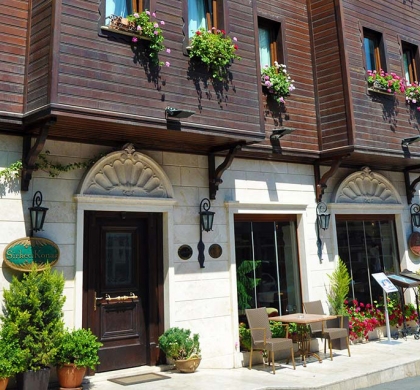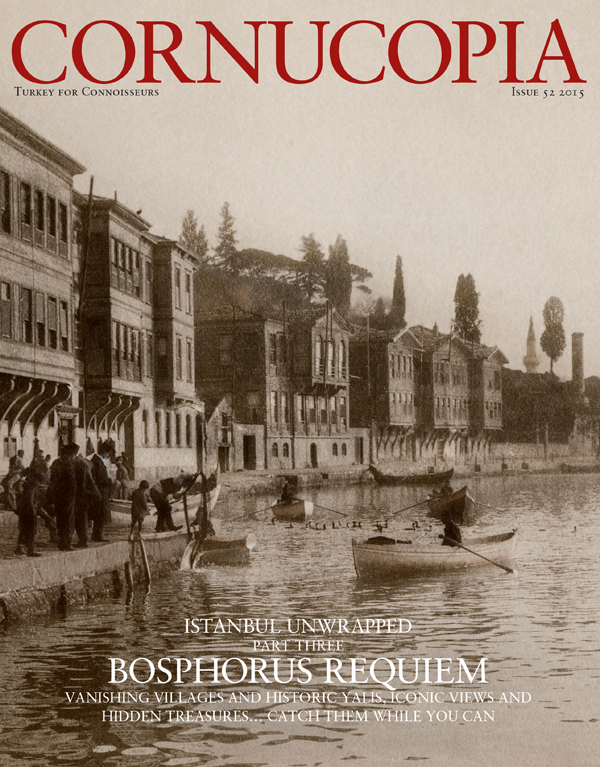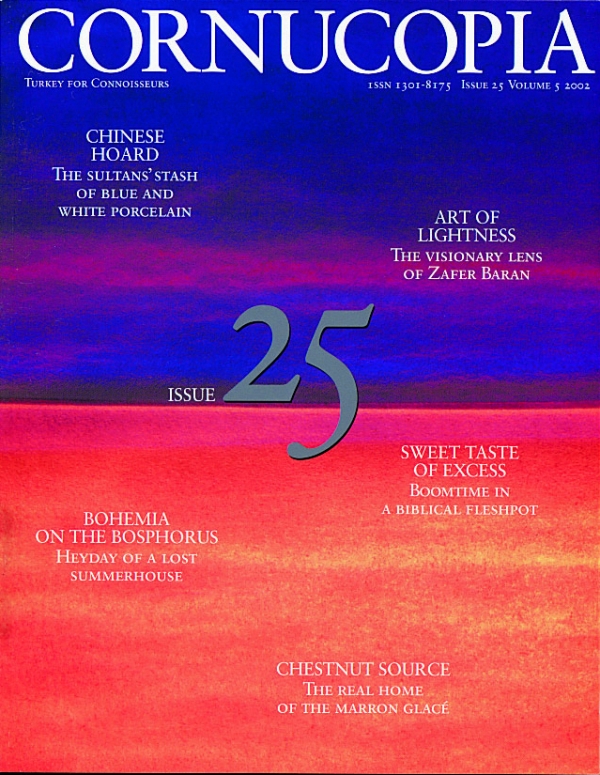Buy or gift a stand-alone digital subscription and get unlimited access to dozens of back issues for just £18.99 / $18.99 a year.
Please register at www.exacteditions.com/digital/cornucopia with your subscriber account number or contact subscriptions@cornucopia.net
Buy a digital subscription Go to the Digital EditionJohn Carswell solves the mystery of the ‘lemon squeezer’ that wasn’t
A couple of years ago at a preview of an Islamic sale at Bonhams, I spied an object on the floor of a vitrine. It seemed familiar, and could it be…? Closer inspection revealed that, yes, it appeared to be a lemon-squeezer, but 400 years earlier than those made by Armenian potters at Kütahya in the early 18th century.
The same size as its successors, it had a boss at the centre and a hole drilled in the base. What was different was that instead of the usual facets, the boss had a head with two protuberant eyes and horns, looking rather like the devil incarnate. Apart from its evil appearance, the horns had a practical function, which was to scour the lemon.
When its unique qualities were pointed out to the owner, Martin Snowdon, he withdrew it from the sale, and I am indebted to him for allowing it to be studied in more detail. What is fascinating is the length of time between the Seljuk example and its reappearance in the lemon-squeezers at Kütahya 600 years later, both of which are based on the same technology. In turn, this can be traced back to a series of Islamic medieval acquamaniles, the earliest of which is dated 796/7 and the latest from Khorosan dated 1206. The hydraulic principle continues in medieval European acquamaniles, of which the Nuremberg lion, c1400, is a splendid example.
The humble pottery lemon-squeezers might seem insignificant compared to their bronze ancestors, but they have their own special interest as the survival of an ingenious idea. As with the later Kütahya examples, the only way to ascertain that the principle was the same was to x-ray the Seljuk squeezer. This was accomplished by the Department of Radiology at the Chelsea and Westminster Hospital in London. The result showed there was an identical central cylinder within the boss. So far, so good.
This led in turn to other questions, such as what was it used for, and what was its function? Up until this point I had assumed it was to produce a quantity of lemon juice, but for what purpose? Lemon juice was certainly used in Islamic cookery in the medieval period, but in Persia a much more important commodity was pomegranate juice. Pomegranates were commended several times by the Prophet Mohammed in the Koran (surat l-an’am). In a unique Chinese treatise of ad1330 (Yin-Shan Cheng-Ya, A Soup for the Qan, London, 2000), pomegranates are mentioned many times, particularly as of Western origin, for the manufacture of a syrup to be diluted and drunk, and in cooking as an ingredient of mudaqqaqat hamida, a stew of meatballs, herbs and condiments. To bring things up to date, pomegranate syrup is an essential ingredient of fesenjan, a tart stew of chicken and walnuts, in Iran today.
To return to the “Seljuk lemon-squeezer” in light of the above, it should now be relabelled as a Persian pomegranate-squeezer. Those devilish horns would be ideal for separating the seeds from the pith.
John Carswell’s latest book, ‘Mantai: City by the Sea’, co-edited with Siran Deraniyagala and Alan Graham (Linden Soft, £56), records excavations in Sri Lanka between 1980 and 1984 and is now available.
Hidden away in one of Istanbul’s least prepossessing neighbourhoods is a walled garden surrounding a dream of a kiosk – a favourite of many sultans.
Give yourself over to the grit and bustle of Eminönü’s waterside markets, then ascend to Sinan’s sublime hilltop mosques – the awesome Süleymaniye and the haunting Şehzade. In their shadow is the exuberantly tiles Rüstem Pasha Mosque. Cornucopia devotes 24 pages to this vibrant area, with features on Eminönü and the Suleymaniye district with photographs by Jürgen Frank, and a guide to the mosques beautifully depicted by Fritz von der Schulenburg
Within the deepest reaches of the palace lies the very seat of the sultans’ power
The Grand Bazaar: From Iznik to Armani, objets d’art to handloomed carpets: the choice is yours
When David Wheeler set out to satisfy his craving to explore Turkish gardens, he was guided by a diverse cast of committed Istanbul citizens. What he discovered were myriad horticultural havens, from Byzantine market gardens to Ottoman cemeteries – many of them under imminent threat.
SPECIAL OFFER: order five beautiful garden-themed issues, including this one, for only £80. List price £122
In his 40-year career, Sinan (1489–1588) transformed the Istanbul skyline. Here we explore three of the chief imperial architect’s masterpieces from the golden age of Süleyman the Magnificent. Photographs by Fritz von der Schulenburg
Justinian’s soaring edifice inspires the same awe today as it did in visitors a millennium ago who wondered if this were Heaven or Earth. Setting out on a tour of the city’s best-preserved Byzantine churches, Robert Ousterhout still senses an air of the miraculous in Ayasofya
The long-awaited Naval Museum has many wonders to reveal, but nothing to compare with the fabulously ornate imperial barges
From a trusty staple to the stuff of feasts, beans are at the very heart of Turkish cuisine. How did we ever live without them?
In a vivid, impressionistic portrait of the Byzantine city, Robert Ousterhout uncovers the history of Byzantium in ten objects, explores the soaring edifice of Ayasofya and picks four of the city’s most inspiring smaller churches.
Take in the Topkapı, where the sultans held sway in secluded grandeur. Saunter round Sultanahmet and the Hippodrome: make the most of the mosques, monuments and museums. Get the buzz of the bazaar: where to snap up covetable collectables and cheerful bargains
Deep in the industrial outskirts of Istanbul, Griselda Warr enters an Aladdin’s cave of Anatolian treasures. Photographs by Fritz von der Schulenburg
AyşeDeniz Gökçin’s musical creations combine the rock-star appeal of Franz Liszt and the psychedelic/progressive brilliance of the band Pink Floyd. Tony Barrell found this prodigiously talented young pianist a force to be reckoned with. Photograph by Charles Hopkinson
In a decade of monitoring Turkey’s burgeoning wine industry, Kevin Gould has never been more impressed. He and the Cornucopia tasting team enthusiastically sampled this year’s top bottles and nominated their favourites
It is a joy to explore. New universities, a new museum, and a growing band of new aficionados who have invested modest means in old houses, have created a wonderful sense of optimism. But the ancient waterfront is in the eye of the storm, with many quarters due to be bulldozed and the threat of a hideous new marina. Enjoy it while you can







Cornucopia works in partnership with the digital publishing platform Exact Editions to offer individual and institutional subscribers unlimited access to a searchable archive of fascinating back issues and every newly published issue. The digital edition of Cornucopia is available cross-platform on web, iOS and Android and offers a comprehensive search function, allowing the title’s cultural content to be delved into at the touch of a button.
Digital Subscription: £18.99 / $18.99 (1 year)
Subscribe now